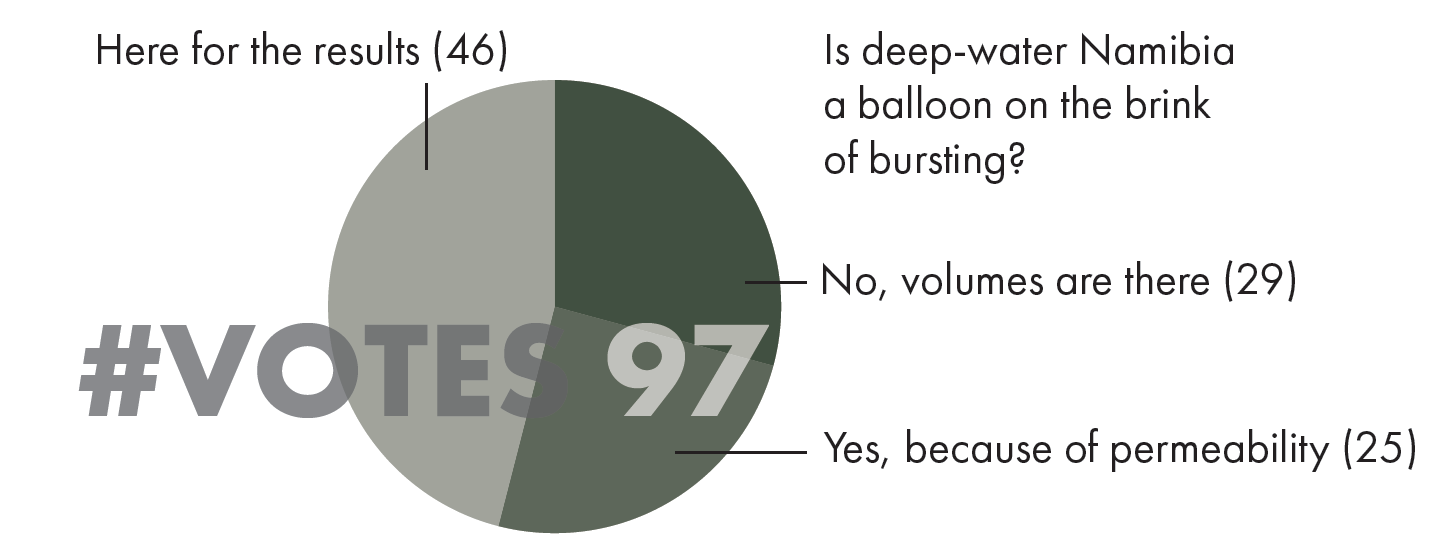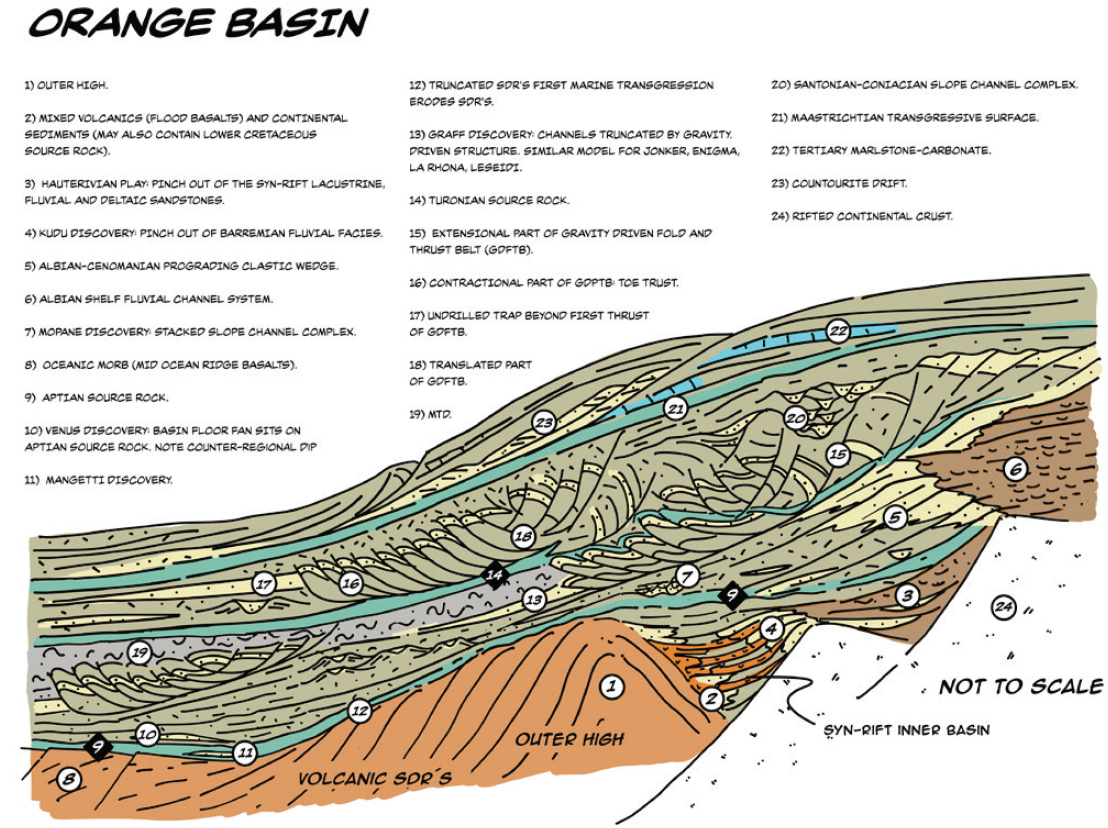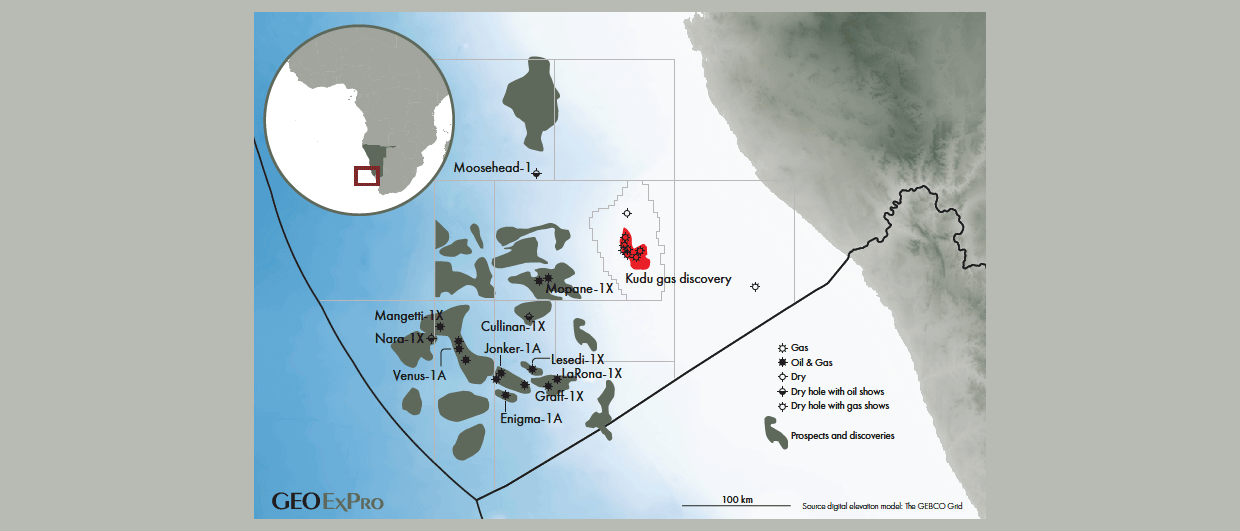“People don’t dream anymore”, said Marcio Mello when he started his talk about Namibia’s deep-water petroleum plays at the IMAGE conference in Houston in August 2024, referring to the dreaming that is required to come up with new exploration ideas.
I had never heard from Marcio Mello before, but he made sure that his talk was delivered in such a way that it became an event to remember. It was a show, something I had not experienced before at a conference. Most people present whilst standing behind a lectern; some go a bit further and walk across the stage, but Marcio walked towards the audience, and he looked people straight in the eye. He was on a mission.
In 2010, credited as the geological mastermind behind Brazil’s pre-salt success, he and his company, HRT, acquired three licenses offshore Namibia, primarily to explore for similar pre-salt resources. “It is all very simple”, he continued his talk. Yet, he resigned from HRT in 2013 before it even spudded the first of three dry or uncommercial wells.
Were the three unsuccessful HRT wells drilled in Namibian waters the reason for stopping dreaming? Of course not, as we will see a little further down this article.
And now we are where we are today, with eight sizeable discoveries made in the Orange Basin. There is no need to spell them all out because everybody is aware of these major finds.
But, there is a but. As Graeme Bagley from Westwood Global Energy Group put it in an interview with us the other day: “If the Namibian discoveries were on the same timeline as the Liza discovery in the Stabroek licence offshore Guyana, the Venus and Graff discoveries would have received FID already”. Tako Koning wrote in his long but very readable overview of the state of play in deep-water Namibia for the Africa Oil and Gas Report; “both Shell and TotalEnergies are distinguished by their lack of information on the quantities of oil and gas to date.”
What is going on? That’s what this article is about. Not because we claim to have the answers, but to explore what is supposed to be the issue a little more. We will approach it in three different ways. First, we held a poll amongst our readers and put the question to them: What do you think the future for Namibia holds? Then, we look in a bit more detail at one of the issues that has been rumoured to be a key problem – chlorite cementation. We talked to Professor Richard Worden from Liverpool University to learn about chlorite. Finally, we briefly touch on another aspect that may prevent a quick FID, which is the supposedly high gas content of the discoveries.
Reduced permeability due to impurities can lead to lower recovery rates. Given that approximately 3.6 billion barrels of oil equivalent have been discovered since 2022, any hindrance due to permeability could significantly impact the overall production efficiency and economic viability of these fields
Masum Akter, Rystad Energy
All of this is illustrated by a new diagram by Marcos Asensio from Argentina, who shows the main elements of the Namibian petroleum system as they have been unearthed over the past few years. Neil Hodgson from Searcher, who also likes to dream as he writes his epic foldout articles, greatly helped put all the elements shown in the diagram in place.
The poll
“ExxonMobil withdraws from race to buy a stake in Namibia oil block from Galp”, wrote Namibia Mining and Energy recently. “It may not be long before one of the majors pull out of Namibia”, someone with knowledge on the matter told me the other day. It paints a picture, combined with what we wrote in the introduction, of a situation that is not as booming as it was two years ago.
What is the reason why the discoveries offshore Africa are not advancing to FID yet? The answer may be in subsurface complexities, as Wael Sawan, Shell’s CEO, recently hinted. Combined with an earlier insight that permeabilities may be problematic due to a diagenetic mineral – probably chlorite, we put up a poll to ask the readership about their point of view.

The question was: “Is deep-water Namibia a balloon on the brink of bursting?” People were able to vote for “No, volumes are there”, “Yes, because of permeability”, and “Here for the results.”
The outcome of the poll, for which 97 people cast their vote, was interesting. It ended in an almost 50/50 split when it comes to people believing in the future of deep-water Namibia and those who are still holding their breath. However, the poll also attracted lots of people keen to see what their peers voted, as the number of “viewers” turned out to be almost 50 % of those interacting with the poll. Probably the highest percentage of the polls we have organised so far. Amongst the “No” voters, it is interesting to note that there were people from Shell and TotalEnergies, so people who may have some insight on the matter. We did approach some voters for comments, but it is always a challenge to get people to elaborate.
“THEY WERE CLOSE”
“They were close”, I overheard someone saying during a conversation about Namibia’s Orange Basin exploration history. We are not talking about the discovery of the Kudu gas field, which took place in 1974 already, but the subsequent phase of exploration in the Orange Basin that was ignited when Brazilian company HRT applied and was awarded a block in 2010.
Led and founded by geologist Marcio Mello, who had played an important role in discovering Brazilian’s pre-salt play, HRT drilled a total of three wells in Namibian waters, Wingat-1 and Murombe-1 in the Walvis Basin and Moosehead-1 in the Orange Basin. With Moosehead being almost on trend with Mopane, it is justified to say that the Orange Basin could equally have been opened up some years earlier.
The main objective of the Moosehead-1 well was to test the resource potential of Barremian-aged carbonate reservoirs, which were expected to be equivalent to the ‘pre-salt’ reservoirs of Brazil and Angola. The Moosehead-1 well encountered about 100 meters of carbonates at the primary target, but the reservoir was less developed than expected at this location, and it was therefore classified as a dry hole.
The prize was ultimately found even further out into the deep, in sediments overlying the oceanic crust, as TotalEnergies and Shell were going to demonstrate in 2022. Twelve years after HRT sniffed around.
But as far as Venus is concerned, the original idea to go for a deep-water play rather than a Brazilian pre-salt analogue did not stem from TotalEnergies. It was the late Dave Roads from Impact Oil and Gas, who interpreted the Venus prospect and came up with the idea to start looking at the sands that could have been deposited by Cretaceous river and delta systems, shifting away from the focus on Tertiary targets such as the Niger Delta. At the end of the day, Jubilee had shown the potential of Cretaceous systems, and why could that not be replicated somewhere else?
“The biggest risk at the time of mapping Venus was the charge model”, as Phil Birch from Impact said during a talk about the Venus discovery in August 2022 in London. Many thought it was impossible to cook a source rock overlying oceanic crust. That model has been clearly revised.
A pointless poll
Some people were not impressed with the way the poll was worded. Mike Hubbard argued that there are many more factors at play that could prevent the Namibian discoveries from becoming a success story, such as low reservoir pressure or high viscosity oil, which led him to conclude the poll was pointless. Of course, he is right in saying that there are other factors at play, but the spirit of the poll was intended to test the thinking of people around the future of the basin, added by the fact that we had heard a mineral is the factor that is causing reservoir issues.
Where is the extended well test?
An interesting conversation we had after the poll was around testing the discoveries. One petroleum geologist mentioned that extended well testing has not yet been performed because of the costs being prohibitive. Alan Foum, however, commented on the lack of an extended well test, as it is seen as a way to have a better understanding of well behaviour. Nick Madden replied to that, saying that the reservoirs should be world-class, so why would you bother? Maybe we should bother, in the light of Sawan’s comments.
Chlorite
There have been hints in the public domain that chlorite cementation has had a detrimental effect on the reservoir properties of the deep-water finds in Namibian waters. Is that a surprise?
For many working in oil and gas, the presence of chlorite may initially sound as good news, given the well-reported phenomenon of chlorite coatings forming around quartz minerals and the resulting quartz growth inhibition.
But can chlorite be detrimental to reservoirs as well? “Very much so”, said Professor Richard Worden from Liverpool University in England, who has studied chlorite formation in sedimentary systems for many years.
“We are looking at a sliding scale”, Richard explains. “No chlorite in a deeply buried reservoir usually means terrible porosity / permeability because of quartz cementation. At the other extreme, too much chlorite means the same thing, but now the pore-filling agent is chlorite itself. We need just the right amount, between 3 and 13 %, to be in the sweet spot, or what I would call the Goldilocks zone.”
That’s not to say that a particular sandstone is in one of the there above-mentioned categories. “It is quite common to see all three cases because chlorite or its precursor minerals are never evenly distributed across the sandstone to start with”, Richard adds.
What are the most common sandstones to chlorite in? “If someone comes to me saying that they have a chlorite-cemented sandstone, my first guess would be that this person has an estuarine or shallow marine sandstone. A deep marine sandstone, such as the reservoirs in Namibia, would not be my first call”, says Richard. “Saying that, there are other marine fan sandstone examples containing chlorite, for instance the Forties reservoir in the North Sea. There are bits of reports and hints in the literature that suggest this is the case. The big difference between Forties sandstones and the Namibian equivalents is that the former are not really benefitting from the presence of chlorite yet because they haven’t been buried deeply enough, and quartz overgrowth has not really been an issue.”
The Orange River was a dirty river. But further north, reservoir quality should improve
Marcio Mello, BPS
How does chlorite form? Chlorite, an iron / magnesium phyllosilicate or clay mineral, is mostly made up of iron, aluminum and silicon, with a little bit of magnesium, oxygen and hydrogen. “Magnesium is very mobile in the subsurface, so we don’t worry about that one”, says Richard. “But aluminum, iron and silicon are not, meaning that they tend to stay where they were deposited initially. And of those three, aluminum (feldspars) and silicon (quartz) are generally not the limiting factor; that is the role iron tends to play.”

“In the Namibia case”, concludes Richard, “where we are probably dealing with well-sorted deep-water sandstones, the “best” way to introduce the elements needed for the formation of chlorite are rock fragments, and in this case probably volcanic rock fragments. It may not have been chlorite when it was deposited; it could have hornblende or pyroxene at the time of deposition, but the building blocks were there, and all you need is some cooking.”
Bubble point
Besides chlorite being a potential issue in the Namibian deep-water discoveries, there are also reports that a high gas content is a problem. Why is that? The risk is that the reservoirs are close to the bubble point, which means that as soon as production starts and pressure drops, gas will come out of the solution and make its way into the wellbore, inhibiting the production of oil.
Dealing with this right from the start is a big difference, for instance, compared to Guyana, where oil could be produced first before a gas solution is now being worked on. The same holds for Baleine in Côte d’Ivoire, where the GOR is supposedly low, enabling the operator to first focus on oil production. This may be one of the reasons, in addition to the chlorite problem, that has thus far prevented companies from giving the go-ahead because the engineering solution is more costly, especially given that this is deep water.
As Namibia seeks to enhance its oil recovery through techniques such as water flooding, impurities can migrate and accumulate in pore throats during these processes. This accumulation can lead to further reductions in permeability, complicating recovery efforts and potentially hindering production efficiency
Masum Akter, Rystad Energy
In fact, the presence of chlorite could be an intricate part of the bubble point problem because it may have resulted in a reservoir that is characterised by sections that are completely clogged up, in combination with intervals that still have good reservoir potential. These high-permeability streaks will be the “highways” along which gas will enter the wellbore once pressure starts dropping.
Why would the oil be gas-rich? Looking at the cross-section, it is not so hard to imagine why this is the case – the Venus reservoir is thought to be directly sitting on top of the source rock. For Graff and equivalent finds, the gas problem may be a bit less serious, as these are a little further away from the source rock.
The way forward
Namibia and the E&P companies trying to firm up the juicy deep-water resource base seem to have woken up from a dream. In the present day, it is more likely that engineers and geoscientists are hard at work coming up with practical solutions to make their discoveries work. For the explorationists, the next frontier already looms. Marcio Mello dreamt when he brought his ideas across from Brazil to Namibia in the early 2010s. Now it is time to continue dreaming and bring the experiences from Namibia back to Brazil, as Neil Hodgson, Karyna Rodriguez, and Lauren Found does on page 46 of this magazine.

